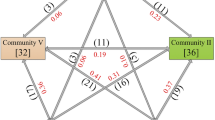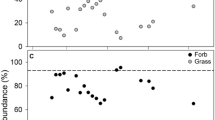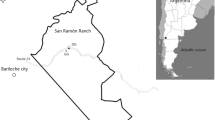Abstract
The spatial heterogeneity of vegetation and soil increases in response to land degradation caused by grazing mainly at a large spatial scale. This increase has been frequently associated with shrub invasion, but shrub invasion does not necessarily accompany land degradation. Instead, dominance by unpalatable forbs has been reported in some regions, but the spatial heterogeneity of such degraded rangeland has not been studied. We investigated the spatial heterogeneity of rangeland dominated by unpalatable forbs at a large spatial scale using Mongolian rangeland as an example. Spatial heterogeneity of the total vegetation cover and community heterogeneity were analyzed for three levels of land degradation. We found that the least-degraded site had homogeneous total vegetation cover and community, that the site with intermediate degradation exhibited low heterogeneity of the total vegetation cover but significant community type variation, and that the most degrade sites exhibited a periodic pattern of total vegetation cover as a result of a mixture of dense and sparse patches of unpalatable forbs. These different responses can be used to assess land degradation levels and may have potential to monitor land degradation at a large scale by satellite images.





Similar content being viewed by others
References
Abubakar SM (1997) Monitoring land degradation in the semiarid tropics using an inferential approach: the Kabomo basin case study, Nigeria. Land Degrad Dev 8:311–323
Adger WN, Benjaminsen TA, Brown K, Svarstad H (2001) Advancing a political ecology of global environment discourses. Dev Change 6:681–715
Adler PB, Raff DA, Lauenroth WK (2001) The effect of grazing on the spatial heterogeneity of vegetation. Oecologia 128:465–479
Augustine DJ (2003) Spatial heterogeneity in the herbaceous layer of a semi-arid savanna ecosystem. Plant Ecol 167:319–332
Augustine DJ, Frank DA (2001) Effects of migratory grazers on spatial heterogeneity of soil nitrogen properties in a grassland ecosystem. Ecology 82:3149–3162
Bakker JP, de Leeuw J, van Wieren SE (1983) Micro-patterns in grassland vegetation created and sustained by sheep-grazing. Vegetatio 55:153–161
Beals EW (1969) Vegetational change along altitudinal gradients. Science 165:981–985
Bertiller MB, Bisigato AJ (1998) Vegetation dynamics under grazing disturbance. Ecol Austral 8:191–199
Bertiller MB, Ares JO, Bisigato AJ (2002) Multiscale indicators of land degradation in the Patagonian Monte, Argentina. Environ Manage 30:704–715
Bisigato AJ, Bertiller MB (1999) Seedling emergence and survival in contrasting soil microsites in Patagonian Monte shrubland. J Veg Sci 10:335–342
Bisigato AJ, Bertiller MB (2004) Temporal and micro-spatial patterning of seedling establishment. Consequences for patch dynamics in the southern Monte. Argentina Plant Ecol 174:235–246
Bisigato AJ, Bertiller MB, Ares JO, Pazos GE (2005) Effect of grazing on plant patterns in arid ecosystems of Patagonian Monte. Ecography 28:561–572
Breiman L, Friedman JH, Olshen RA, Stone CG (1984) Classification and regression trees. Wadsworth International Group, Belmont
Chen X, Duan Z (2009) Changes in soil physical and chemical properties during reversal of desertification in Yanchi County of Ningxia Hui autonomous region, China. Environ Geol 57:975–985
Chen L, Michalk DL, Millar GD (2002) The ecology and growth patterns of Cleistogenes species in degraded grassland of eastern Inner Mongolia, China. J Ecol 39:584–594
Cheng X, An S, Chen J, Li B, Liu Y, Liu S (2007) Spatial relationships among species, above-ground biomass, N, and P in degraded grasslands in Ordos Plateau, northwestern China. J Arid Environ 68:652–667
de Soyza AG, Whitford WG, Herrick J, Van Zee JW, Havstad KM (1998) Early warning indicators of desertification: examples of tests in the Chihuahuan Desert. J Arid Environ 39:101–112
de Soyza AG, Van Zee JW, Whitford WG, Neale A, Tallent-Hallsel N, Herrick J, Havstad KM (2000) Indicators of Great Basin rangeland health. J Arid Environ 45:289–304
Fernandez-Gimenez ME, Batbuyan MR (2004) Law and disorder: local implementation of Mongolia’s land law. Dev Change 35:141–165
Gao YZ, Wang SP, Han XG, Patton BD, Nyren PE (2005) Competition between Artemisia frigida and Cleistogenes squarrosa under different clipping intensities in replacement series mixture at different nitrogen levels. Grass Forage Sci 60:119–127
Goovaerts P (1997) Geostatistics for natural resources evaluation. Oxford University Press, New York
Hobbs NT, Swift DM (1988) Grazing in herds: when are nutritional benefits realized? Am Nat 131:760–764
Hoshino A, Yoshihara Y, Sasaki T, Okayasu T, Jamsran U, Okuro T, Takeuchi K (2009) Comparison of vegetation changes along grazing gradients with different numbers of livestock. J Arid Environ 73:949–954
Jigjidsuren S, Johnson DA (2003) Forage plants of Mongolia. Admon Publishing, Ulaanbataar
Li CL, Hao XY, Zhao ML, Han GD, Willms WD (2008) Influence of historic sheep grazing on vegetation and soil properties of a Desert Steppe in Inner Mongolia. Agric Ecosyst Environ 128:109–116
Lin Y, Hong M, Han GD, Zhao ML, Bai YF, Chang SX (2010) Grazing intensity affected spatial patterns of vegetation and soil fertility in a desert steppe. Agric Ecosyst Environ 138:282–292
Milchunas DG, Noy-Meier I (2002) Grazing refuges, external avoidance of herbivory and plant diversity. Oikos 99:113–130
Moen R, Cohen Y, Pastor J (1998) Linking moose population and plant growth models with a moose energetics model. Ecosystems 1:52–63
Mouissie AM, Apol MEF, Heil GW, van Diggelen R (2008) Creation and preservation of vegetation patterns by grazing. Ecol Model 218:60–72
National Statistical Office of Mongolia (2007) Mongolian statistical yearbook 2006. National Statistical Office of Mongolia, Ulaanbaatar, p 401
Okayasu T, Muto M, Jamsran U, Takeuchi K (2007) Heterogeneous impacts on rangeland after social system change in Mongolia. Land Degrad Dev 18:555–566
Posse G, Anchorena J, Collantes MR (2000) Spatial micro-patterns in the steppe of Tierra del Fuego induced by sheep grazing. J Veg Sci 11:43–50
Reynolds JF, Virginia RA, Schlesinger WH (1997) Defining functional types for models of desertification. In: Smith TM, Shugart HH, Woodward FI (eds) Plant functional types. Cambridge University Press, Cambridge, pp 174–194
Reynolds JF, Stafford-Smith DM, Lambin EF, Turner BL II, Mortimore M, Batterbury SPJ, Downing TE, Dowlatabadi H, Fernandez RJ, Herrick JE, Huber-Sannwald E, Jiang H, Leemans R, Lynam T, Maestre FT, Ayarza M, Walker B (2007) Global desertification: building a science for dryland development. Science 316:847–851
Rietkerk M, Ketner P, Burger J, Hoorens B, Olff H (2000) Multiscale soil and vegetation patchiness along a gradient of herbivore impact in a semi-arid grazing system in West Africa. Plant Ecol 148:207–224
Rietkerk M, Ouedraogo T, Kumar L, Sanou S, van Langevelde F, Kiema A, van de Koppel J, van Andel J, Heame J, Skidmore AK, de Ridder N, Stroosnijder L, Prins HHT (2002) Fine-scale spatial distribution of plants and resources on a sandy soil in the Sahel. Plant Soil 239:69–77
Sasaki T, Okayasu T, Takeuchi T, Jamsran U, Jadamba S (2005) Pattern of floristic composition under different grazing intensities in Bulgan, South Gobi. Mongolia Grassl Sci 51(3):235–242
Sasaki T, Okayasu T, Shirato T, Jamsran U, Okubo S, Takeuchi K (2007) Can edaphic factors demonstrate landscape-scale differences in vegetation responses to grazing? Plant Ecol 194:51–66
Schlesinger WH, Raikes JA, Hartley AE, Cross AF (1996) On the spatial pattern of soil nutrients in desert ecosystems. Ecology 77:364–374
Scholes RJ, Archer SR (1997) Tree-grass interactions in savannas. Annu Rev Ecol Syst 28:517–544
Wang XP, Li XR, Xiao HL, Pan YX (2006) Evolutionary characteristics of the artificially revegetated shrub ecosystem in the Tengger Desert, northern China. Ecol Res 21:415–424
Wiesmeier M, Steffens M, Kilbl A, Kogel-Knabner I (2009) Degradation and small-scale spatial homogenization of topsoils in intensively-grazed steppes of Northern China. Soil Tillage Res 104:299–310
Wishart D (1969) An algorithm for hierarchical classification. Biometrics 25:213–251
Acknowledgments
This study was funded by the Global Center of Excellence Program of the Japan Society for the Promotion of Science, Ministry of Education, Culture, Sports, Science, and Technology (“Center of Excellence for Asian Conservation Ecology as a Basis of Human-Nature Mutualism”), and by the Global Environmental Fund of the Ministry of the Environment of Japan (D-1105 “Biodiversity of dryland ecosystem and sustainability of nomadic production in Northeast Asia”). The authors thank Prof. Namkhai Bandi, Director of the Hustai National Park Trust, for kind support of our field surveys. The authors thank Yoshiko Kitagawa for assistance with our vegetation survey.
Author information
Authors and Affiliations
Corresponding author
Rights and permissions
About this article
Cite this article
Okayasu, T., Okuro, T., Jamsran, U. et al. Degraded rangeland dominated by unpalatable forbs exhibits large-scale spatial heterogeneity. Plant Ecol 213, 625–635 (2012). https://doi.org/10.1007/s11258-012-0027-3
Received:
Accepted:
Published:
Issue Date:
DOI: https://doi.org/10.1007/s11258-012-0027-3




